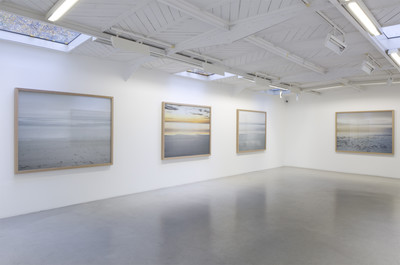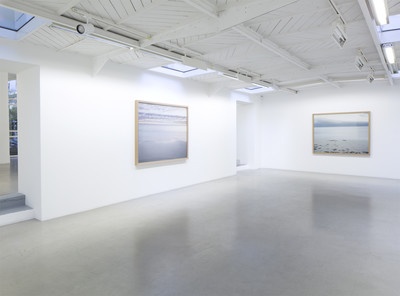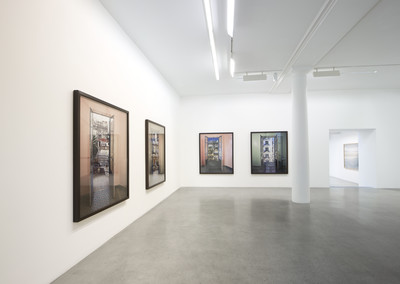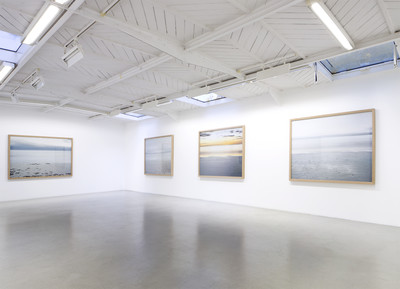




Kamel Mennour is pleased to present ‘Alger, jours blancs’, Marie Bovo’s fourth solo exhibition at the gallery.
« The Mediterranean coast is connected to people, to the history of civilizations and cultures. Each beach looks like it keeps Ulysses’ footsteps. The Lofoten coast brings to mind Moby Dick. Before my trip, I knew one text about Lofoten that I had read some years ago — “A Descent into the Maelström,” the short story by Edgar Allan Poe.
I knew that Captain Nemo wanted to vanish with the Nautilus in 1
Lofoten. » Marie Bovo
With the photographic series Jours blancs2 and Alger, Marie Bovo places exterior landscapes in relation with interior landscapes, emanating as these do from the images on display. She leads us back and forth between one world and another, showing in the process the traces and figures that emerge in the dialogue between people and their environment.
Jours blancs evokes the brightness of the nights beyond the polar circle, on the Lofoten Islands in Norway. This series, produced to the rhythm of the midnight sun—that almost metaphysical night one encounters in the Nordic latitudes—sustains that rare phenomenon, that of the eternal day, light resisting darkness. Water, air, light: these images invite us to plunge suddenly into elements that meet only to disappear into the horizon. These immense images, bathed in a white light, with their rainbow sheen, are all photographed in the same way, with the same proportion of sky and sea, and at regular moments of the night. Before these calming variations of white, the gaze seems to lose itself in the brightness of the Nordic night. “One goes to the Lofoten Islands in order to disappear,’ says Marie Bovo. Strangely luminous and evanescent, these silent landscapes, seemingly empty, are transformed into spaces of contemplation and meditation. At the same time, the beauty of the light and their very peculiar chromatic softness lend her works a sort of timelessness. ‘I have spent hours and hours observing the landscape, looking for nuances. I basically don’t know if I have spent ten days or one eternal day,’ she adds. Her poetic experience of this polar world, of these border regions, have given her a chance to escape from time. Slowly and surely, with her view camera she examines the landscape in order to bring forth its density. The landscape is no longer looked at, it is plumbed. These images give the impression not only of having been taken in the midst of duration, but of continuing to unfold their present before our eyes. In this spectacle of a wilderness of unreal beauty, in this impression one has of spatial and temporal infinity, Marie Bovo seems to identify the only possible eternity. An eternity here and now, present in such moments of rapture and
bedazzlement. In this sense, ‘It has been recovered. / What? – 3
Eternity. / It’s the sea mixed / With the sun.’
It is a sea then, forever rebegun, unfinished and unfinishable, that she photographs. A sea that comes forth through light, following the perpetual back and forth of flux and reflux, of loss and recovery. It is also an interior sea. Visible and invisible, it fills and escapes us. Without beginning or end, it floods and overwhelms us.
—
1 Zeke Turner, « Spaces outside time, An Interview with Marie Bovo », Different Lights Lofoten, Teknisk Industri AS, Oslo, 2013, n. pag.
2 A nuit blanche is an all-nighter. A jour blanc suggests then both a ‘white day’ and an endless one. [Ndt.]
3 Arthur Rimbaud, « Alchimie du Verbe », Une saison en enfer, Délires II, 1873, in Œuvres, Paris, Bordas, 1991, p. 232-233.
Opposite these landscapes endlessly modelled and recomposed by light, Marie Bovo offers images that behave like sequences in an unreal film. Images that immerse us in the profound silence of a city. This introspective dynamic is visually carried out here through the repetition of a single motif—the photographed window—in an apartment in Algiers, at different time intervals. She has created isolated images of great formal stability. Repetition and difference together make up the essential element of this work. Playing with such a variation on a single theme, the photographer directs everything at her disposal towards sculpting and reifying these windows through the play of light. The effect is made stronger by the rules of presentation in force here: the bare, austere record of the place; the refusal of anecdote; the format and the angles she has chosen.
With no promise of release, without perspective, these windows seem to look back at us with the oblique gaze of icons. Themselves trapped within the windows’ frames, the next-door buildings’ facades appear as it were outfaced. Thus the space works like a mechanism for enclosing the back-and-forth of gazes passing between here and over there, inside and outside. The open windows act upon the interior space, inverting the relation between inside and outside. This experience of the outside reveals its deep relation with that of the inside, for the interior becomes exterior, all the while remaining inside. A visual shock. Spaces collide at one moment, only to absorbe one another the next: a tension that
Henri Michaux underlines when he evokes the ‘horror inside / 4
outside that is real space’. Such a group of images radiates with a theatrical and symbolic conception of space. This metaphoric conception—of a mental space at once fictive and experienced— invites the viewer to dive into a world, into an interstitial space between presence and absence, between inside and outside. These spaces become mute, these interior places call out to and demand thought, which soon seems to float. Time finds itself paradoxically suspended, immobile. Architectural vanities, these perspectives embody the borders between two worlds, between our imaginary and reality, between the inside and the outside.
Thus Marie Bovo’s photographic writing sets up a profound relationship with its environment. With her views of Algiers but also her seascapes, she reveals an interior world. A world in which inside/outside, interior/exterior cannot be separated. In her work, there is systematically an exteriorisation beginning in the inside, and an interiorisation beginning in the outside. She plays on this reciprocity to sound the inexpressible, and to open timeless breaches in the contingent experience of the world.
Mouna Mekouar
—
4 Henri Michaux, « L’espace aux ombres », Nouvelles de l’étranger, Paris, Mercure de France, 1952, p. 91.
Born in 1967 in Alicante in Spain, Marie Bovo lives and works in Marseille.
Her work has been shown in solo exhibitions at the Institut français de Madrid, the Maison Européenne de la Photographie in Paris, at the CCC in Tours, at Luis Serpa Projectos in Lisbon, at the Collections de Saint-Cyprian, at the Musée d’art contemporain de Marseille and at the Fondation ERA in Moscow.
Marie Bovo has also participated in numerous group exhibitions: at the Museum of Contemporary Art in Chicago, at Maxxi in Rome, the Institut Culturel Bernard Magrez in Bordeaux as well as for the Venice, Busan and Thessaloniki Biennales, and the Milan Triennale. She will have a solo exhibition at the FRAC Provence- Alpes-
Côte d’Azur in Spring 2015.





You are using an outdated browser.
Please upgrade your browser to improve your experience.